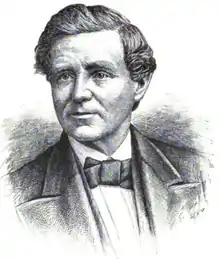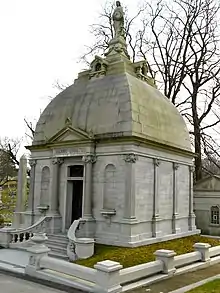Henry Disston
Henry Disston (May 24, 1819 – March 16, 1878) was an English American industrialist who founded the Keystone Saw Works in 1840 and developed the surrounding neighborhood of Tacony in Philadelphia, beginning in 1872.
Henry Disston | |
|---|---|
 | |
| Born | May 24, 1819 Tewkesbury, England |
| Died | March 16, 1878 (aged 58) Philadelphia, Pennsylvania, United States |
| Resting place | Laurel Hill Cemetery |
| Occupation | Industrialist |
| Spouse(s) |
Mary Steelman (m. 1843) |
| Signature | |
 | |
Early life and rise to prominence
Disston was born May 24, 1819 in Tewkesbury, England.[1] He arrived in America, as a boy of 14 with his 16-year-old sister, Marianna. Three days after arriving in Philadelphia they were orphaned by the sudden death of their father, Thomas Disston, who had brought them there. Henry Disston took a job there as a saw-maker's apprentice. In 1840, he left Lindley, Johnson & Whitcraft started and started his own saw-making business.[1] Around the time he opened his shop he married Amanda Bickley. She tragically died not long after giving birth to twins who only survived a few hours. He later remarried to Mary Steelman in 1843.[2]
By 1850, Disston's saws were renowned in the United States, even as compared against the English manufactures that were usually thought superior. Disston encouraged emigration from England to staff his factory with skilled workers. During the American Civil War, a protective tariff on foreign manufactured goods helped expand Disston's enterprise still more, and despite a fire that ruined the factory, Disston prospered through the 1860s.[1]
Move to Tacony
By 1871, Disston's saw mill had outgrown its factory and he moved the business to the outlying neighborhood of Tacony, in what is now Northeast Philadelphia. At the time, Tacony was a small outlying area of Philadelphia, but it was located near the railroad and the Delaware River, and provided Disston with room for his saw mill to grow.[1] Disston constructed homes for his workers, and designed them in an effort to improve their surroundings from their former dwellings in Philadelphia. This area of Tacony, known as the Disston Estate, was designed to bear Disston's imprint in the fashion of true Victorian utopianism.
Skewback saw
Disston's "skewback saw", was developed around 1874, anecdotally based on a chalk design created on an office floor, and gained significant market share, though whether the design itself was superior, or the all round high quality of Disston's materials and production is not clear.
Failing health and death

By the late 1870s, Disston's business and social enterprises were succeeding, but his own health was failing. Despite his failing health, Disston generously supported the founding of a homeless shelter, Sunday Breakfast Rescue Mission.[3] After falling ill in 1877, he suffered a stroke and died at his home in Philadelphia on March 16, 1878.[1][4] He is buried at Laurel Hill Cemetery.
References
- The National Cyclopaedia of American Biography. VI. James T. White & Company. 1896. p. 146. Retrieved November 27, 2020 – via Google Books.
- Disston. "Henry Disston (1819-1878) Pioneer Industrialist Inventor and Good Citizen".
- Avery, Ron (May 22, 1995). "A Mission With Praying Power For 117 Years, It Has Sheltered & Fed Hungry Men". Philadelphia Inquirer. Philadelphia Media Network. Retrieved June 15, 2015.
- "Obituary". Chicago Tribune. March 17, 1878. p. 3. Retrieved November 27, 2020 – via Newspapers.com.
External links
- Disstonian Institute on-line reference for collectors of handsaws
- Henry Disston at Find a Grave